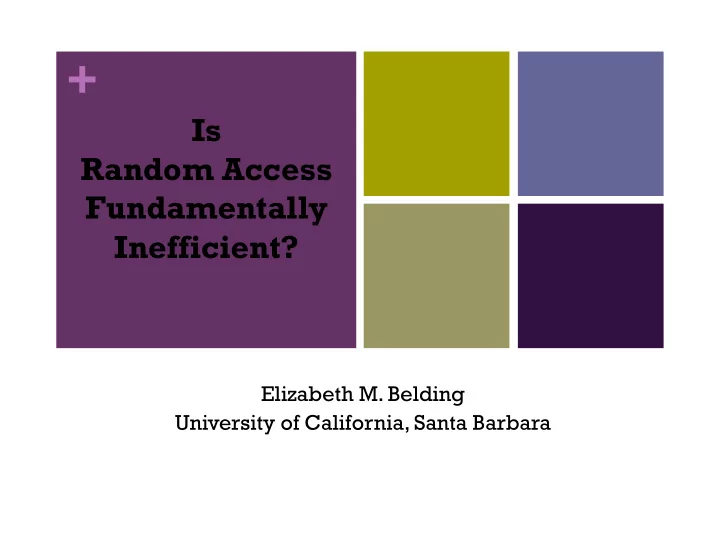

+ Is Random Access Fundamentally Inefficient? Elizabeth M. Belding University of California, Santa Barbara
+ Is random access fundamentally inefficient? Yes. It does not prevent collisions. No. If there is only one transmitter, it’s terrific. It depends. Number of transmitters, traffic profile, mobility, etc. Whether or not its fundamentally inefficient, our protocols aren’t close to optimal and could be doing a lot better.
+ Why would random access be considered inefficient? Collisions. Collisions increase as usage increases, resulting in lower throughput Are collisions the only reason for the rate decrease?
+ Interference challenges in current wireless solutions IEEE 802.11: Decreases rate when collisions occur Auto-rate fallback (ARF) “Binary” assumption of interference Not true in real networks
+ Auto-Rate Fallback (ARF) Designed to respond to poor signal quality x consecutive losses results in decrease in data rate y consecutive packet receptions results in increase in data rate
+ 802.11 Data Rate Usage Data from 67 th IETF meeting: more than 1000 attendees in a room with 16 APs
+ 802.11 Data Rate Usage Rate Packets (%) Rate Packets (%) (Mbps) (Mbps) 11 72.94 36 3.9 12 1.53 48 3.59 18 2.76 54 11.51 24 2.76
+ 802.11 Data Rate Usage Rate Packets (%) Rate Packets (%) (Mbps) (Mbps) 11 72.94 36 3.9 12 1.53 48 3.59 18 2.76 54 11.51 24 2.76
+ What can be done? Differentiate the cause of loss Only reduce data rate when the cause of loss is due to poor link quality, not collisions WOOF: Wireless cOngestion Optimized Fallback (WOOF) Use correlation of channel utilization and packet loss rate to help distinguish cause of loss
+ WOOF Performance
+ WOOF Data Rates Data Rate (Mbps) WOOF (%) SampleRate (%) 1 .001 2.4 2 .009 .02 5.5 .001 1.5 6 .008 21.1 9 0 0 11 .04 20.8 12 .02 6.2 18 .2 6.8 24 .78 9.4 36 5.4 13.4 48 19.7 8.8 54 73.4 9.4
+ Interference as a binary number Commonly used assumption: Interference either exists, or it doesn’t If it exists, all packets from a sender will interfere with nodes in interference range Not true in real networks
+ Medium utilization and reception behavior for three representative links
+ How can random access be improved? Make collisions work for you, not against you Network coding [Katabi’07] Perform interference prediction to know which links will interfere [Padhye’05] Design pseudo-random access solutions so non-interfering nodes transmit at the same time [Mittal’06] Don’t decrease data rates due to collisions [Acharya‘08] Differentiate the cause of packet loss [Acharya’08, Banerjee’08] Dynamic TDMA solutions [Singh ‘07] The best of both worlds Add intelligence to high layers Others…
Recommend
More recommend